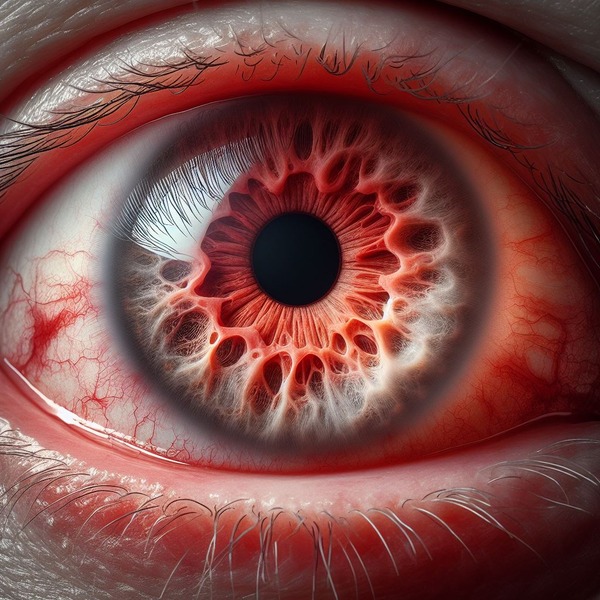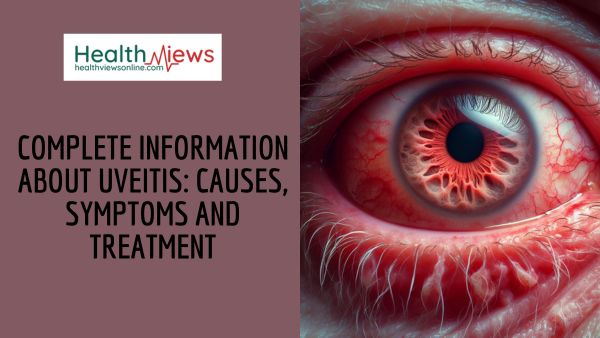What is Uveitis?
Uveitis is a swelling of the uvea, the central layer of the eye. It can be caused by both infectious and non-infectious agents. The retina receives its blood supply from the uvea. The retina is the light-sensitive portion of the eye that focuses and sends images to the brain. It is generally crimson due to the uveal blood supply. Source
Uveitis is usually not dangerous. If not treated promptly, more severe cases can result in vision loss. Various types of uveitis affect various areas of the uvea:
- Anterior uveitis – Anterior uveitis, also known as iritis, affects the front part of the eye and is recognised by doctors by the presence of white blood cells and fibrin in the anterior segment, which is the eye’s front portion.
- Intermediate uveitis – It is also known as vitritis or pars planitis. Vitritis is an inflammation of the vitreous cavity, which is the jelly-like portion of the eye.
- Posterior uveitis – It is an inflammation of the retina and the choroid. The back of the eye is referred to as posterior.
- Panuveitis – Panuveitis is an inflammation of all layers of the uvea. Other parts of the eye, such as the lens, retina, optic nerve, and vitreous, might be affected by this type of uveitis.
Also, read Complete Guide on Retinal Detachment: Causes, Symptoms and Treatment

Causes
Since the exact cause of uveitis is unknown in around half of cases, the condition may be classified as an autoimmune illness that solely affects the eye or eyes. If a reason is found, it could be one of the following:
- An inflammatory or autoimmune disease, like Crohn’s disease, sarcoidosis, or systemic lupus erythematosus, affects different areas of the body.
- Back discomfort can result from ankylosing spondylitis, an inflammatory illness that can fuse portions of the spine’s bones. One of the most frequent side effects of ankylosing spondylitis is uveitis.
- An infection, such as tuberculosis, syphilis, herpes zoster, toxoplasmosis, or cat scratch disease.
- Medication side effects.
- Eye injury or surgery.
- Very rarely, an eye malignancy like lymphoma. Source
Risk factors
Individuals with specific gene mutations may be more susceptible to uveitis. Cigarette smoking has been linked to more difficult-to-manage uveitis.
Diagnosis
During an eye exam, the healthcare expert caring for your eyes will examine the inside of your eye. A standard eye exam typically includes the following components:
- To check for vision loss, a visual acuity test (reading eye charts) is performed.
- Tonometry to determine the pressure inside the eye.
- Slit-lamp examination examines the inside of the eye with a special microscope known as a slit lamp.
- Dilated eye exam to dilate pupils so your doctor may check into your eyes with a special lens.
Also, your doctor can recommend additional testing like:
- Blood tests are used to rule out infections and autoimmune disorders.
- Chest or brain imaging to search for systemic inflammatory causes.
- Fluorescein angiography is used to photograph blood vessels in the rear of the eye.
- Gonioscopy to inspect the front of the eye, where liquid empties.
- OCT to provide detailed images of the back of the eye, including the retina.
- OCTA (optical coherence tomography angiography) to create 3D images of blood flow through the eye.
- A visual field test to detect optic nerve injury that may impair your ability to perceive things off to the side (peripheral vision).
Treatment
The treatment for uveitis is determined by the etiology and type of uveitis. It is usually treated with eye drops. If your uveitis is caused by another ailment, treating the underlying problem may help you get rid of it. The treatment’s purpose is to minimize inflammation in the eye. Source
The following are the most prevalent treatment options for each form of uveitis:
- Dark glasses, eye drops to widen the pupil and relieve pain, and steroid eye drops to reduce inflammation or irritation are all used to treat anterior uveitis, also known as iritis.
- Steroids used orally, injections around the eyes, and follow-up appointments with other doctors to address the autoimmune condition or infection can all be part of the treatment for posterior uveitis. Antibiotics are typically used to treat a bacterial infection of the entire body.
- Steroid eye drops and oral steroids are used to treat intermediate uveitis.
- Immunosuppressive medications may be necessary for severe cases of uveitis.
Diet
Choose fruits like cherries, tomatoes, and blueberries as well as leafy, green veggies and peppers. These extras could be beneficial as well: A daily multivitamin that includes trace minerals like magnesium, calcium, zinc, and selenium along with the antioxidant vitamins A, C, and E as well as the B vitamins.
Prevention
Uveitis can be prevented by receiving the appropriate care for an infection or autoimmune illness. Since the etiology is unknown, uveitis in otherwise healthy individuals is difficult to prevent.
Early detection and treatment are essential for reducing the risk of permanent visual loss.
Also, read Complete Guide on Floaters: Causes, Symptoms and Treatment





